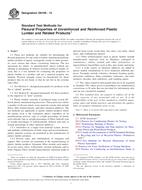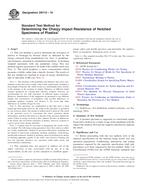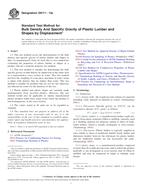We need your consent to use the individual data so that you can see information about your interests, among other things. Click "OK" to give your consent.
ASTM D523-14
Standard Test Method for Specular Gloss
STANDARD published on 1.1.2014
The information about the standard:
Designation standards: ASTM D523-14
Note: WITHDRAWN
Publication date standards: 1.1.2014
SKU: NS-30358
The number of pages: 5
Approximate weight : 15 g (0.03 lbs)
Country: American technical standard
Category: Technical standards ASTM
The category - similar standards:
Annotation of standard text ASTM D523-14 :
Keywords:
appearance, directional reflectance factor, gloss, goniophotometry, high gloss, relative luminous reflectance factor, specular gloss, ICS Number Code 83.140.01 (Rubber and plastic products in general)
Additional information
| Significance and Use | ||||||||||||
|
5.1 Gloss is associated with the capacity of a surface to reflect more light in directions close to the specular than in others. Measurements by this test method correlate with visual observations of surface shininess made at roughly the corresponding angles. 5.1.1 Measured gloss ratings by this test method are obtained by comparing the specular reflectance from the specimen to that from a black glass standard. Since specular reflectance depends also on the surface refractive index of the specimen, the measured gloss ratings change as the surface refractive index changes. In obtaining the visual gloss ratings, however, it is customary to compare the specular reflectances of two specimens having similar surface refractive indices. 5.2 Other visual aspects of surface appearance, such as distinctness of reflected images, reflection haze, and texture, are frequently involved in the assessment of gloss 5.3 Little information about the relation of numerical-to-perceptual intervals of specular gloss has been published. However, in many applications the gloss scales of this test method have provided instrumental scaling of coated specimens that have agreed well with visual scaling (10). 5.4 When specimens differing widely in perceived gloss or color, or both, are compared, nonlinearity may be encountered in the relationship between visual gloss difference ratings and instrumental gloss reading differences. |
||||||||||||
| 1. Scope | ||||||||||||
|
1.1 This test method covers the measurement of the specular gloss of nonmetallic specimens for glossmeter geometries of 60, 20, and 85° (1-7).2 1.2 The values stated in inch-pound units are to be regarded as standard. The values given in parentheses are mathematical conversions to SI units that are provided for information only and are not considered standard. 1.3 This standard does not purport to address all of the safety concerns, if any, associated with its use. It is the responsibility of the user of this standard to establish appropriate safety and health practices and determine the applicability of regulatory limitations prior to use. |
||||||||||||
| 2. Referenced Documents | ||||||||||||
|
Similar standards:
Historical
1.12.2010
Historical
1.5.2012
Historical
1.6.2013
Historical
1.6.2013
Historical
1.4.2010
Historical
1.9.2013
We recommend:
Technical standards updating
Do you want to make sure you use only the valid technical standards?
We can offer you a solution which will provide you a monthly overview concerning the updating of standards which you use.
Would you like to know more? Look at this page.



 ASTM D6098-10
ASTM D6098-10 ASTM D6105-04(2012)..
ASTM D6105-04(2012).. ASTM D6108-13
ASTM D6108-13 ASTM D6109-13
ASTM D6109-13 ASTM D6110-10
ASTM D6110-10 ASTM D6111-13a
ASTM D6111-13a
 Cookies
Cookies
